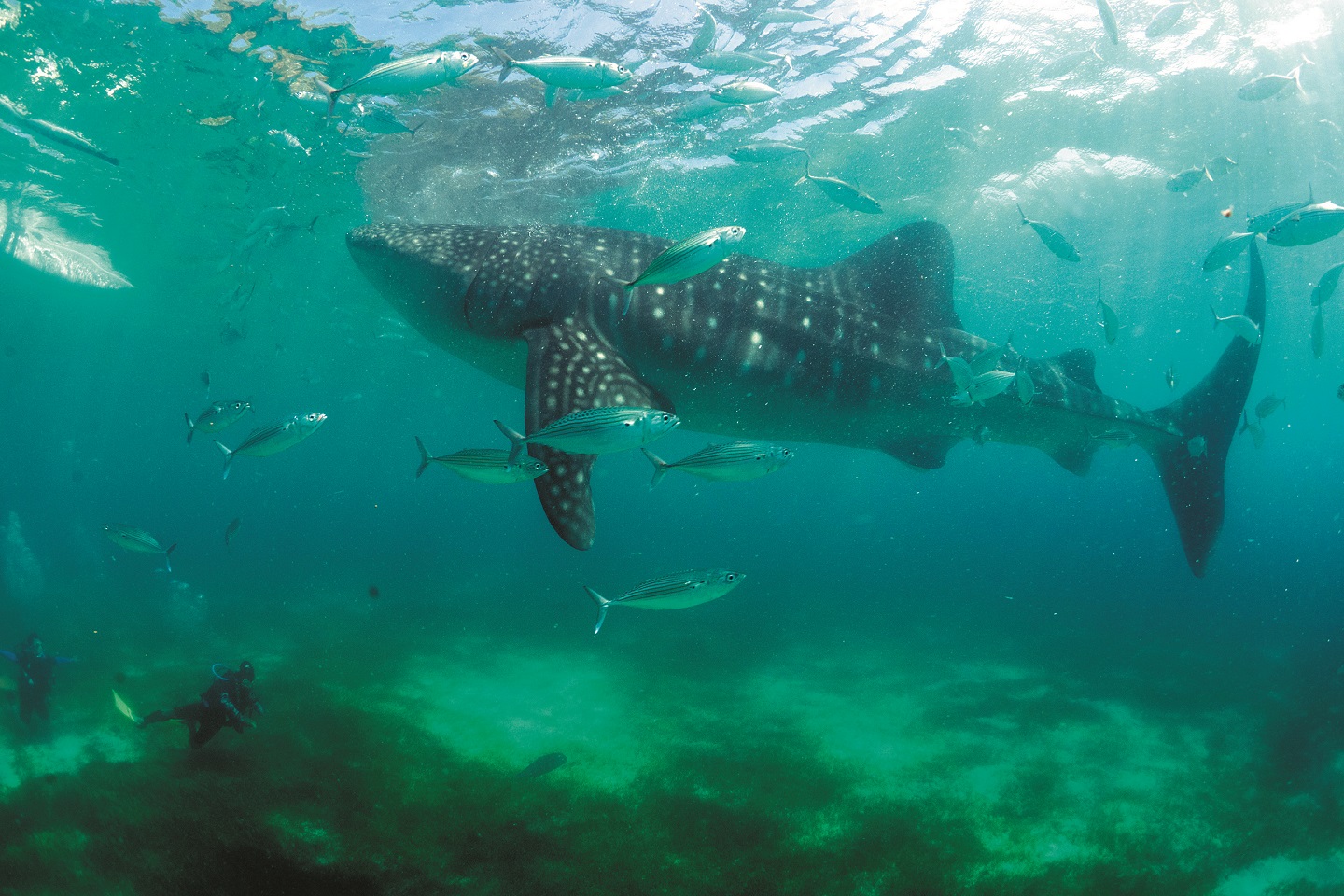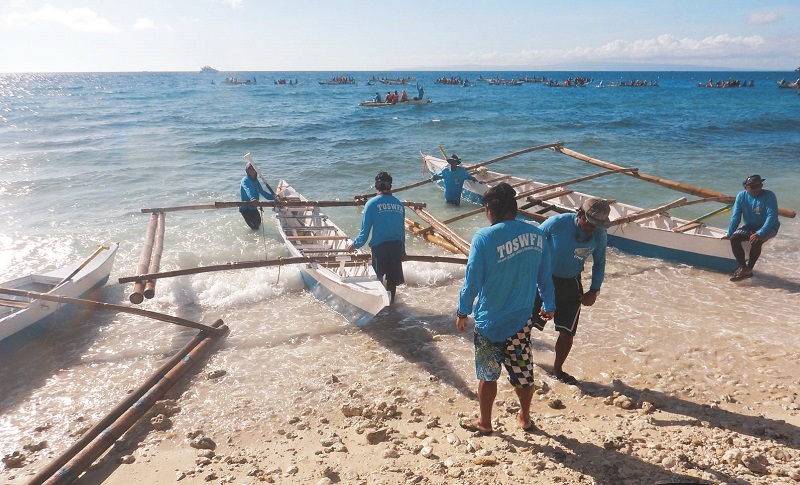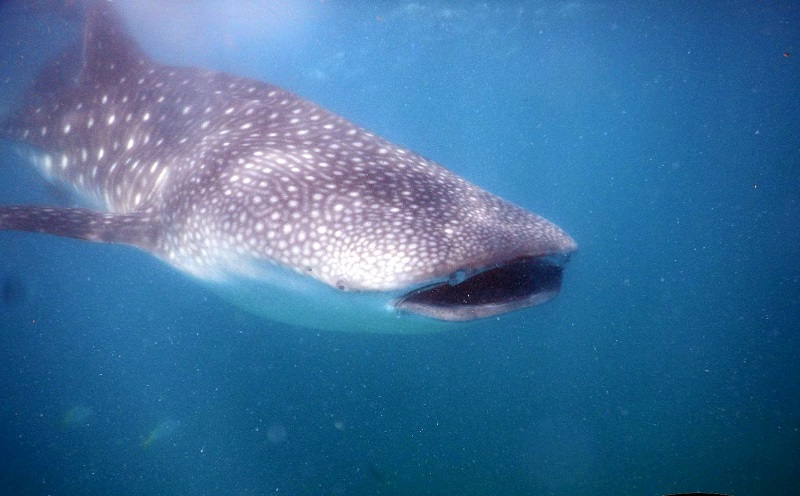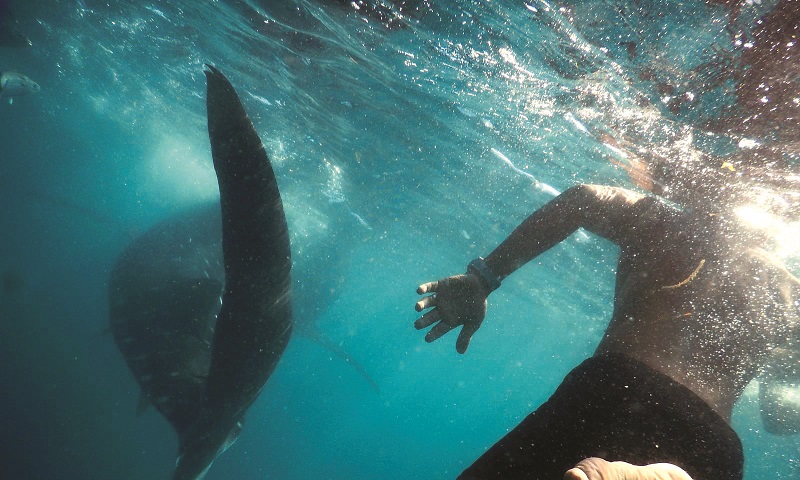
Photo: Underwater pictures by Joyce and Addy Ng
In 2011, a visitor announced to the world via social media that whale sharks could be seen regularly in Oslob, the Philippines. This started a trickle of curious visitors who came to see the whale sharks in their natural environment. Usually, they are only encountered through sheer luck by scuba divers or on organised whale shark observing tours such as those off Australia’s Ningaloo Reef, where spotter planes direct boats to pods of the fish.
Catching sight of a whale shark in Oslob, however, is virtually guaranteed, with some tour companies offering a 100% cash back guarantee. They do so with confidence because there is more than just luck and nature involved. In Oslob, the villagers feed the fish.
The whale shark (Rhincodon typus) is the world’s largest fish. (Whales are bigger, but they are not fish; they are mammals.) The whale shark is a filter feeder, ingesting large amounts of water and filtering the plankton, krill and small fish out of it. It is completely harmless to humans, unless you get smacked by its considerable tail, in which case, it’s your fault, not the shark’s. Much remains unknown about whale sharks, but they are migratory, travelling vast distances, and they inhabit warm waters throughout the world. Their status is listed as “vulnerable” by the International Union for Conservation of Nature and Natural Resources.
Whale sharks can grow to enormous sizes, the largest measuring 12.2m and estimated at 21.5 tonnes in weight (about 10 average-sized sedan cars) with unconfirmed reports of even bigger specimens.
My own whale shark spotting journey started in the back of a van with other dozing tourists and snoring tour guides, wending its merry way along the main coastal road of Cebu, past beachside scenes of waving coconut trees and azure waters washing up against pebbly or rocky beaches.
And so to the town of Tan-awan in the municipality of Oslob. After the quiet countryside, the place was abuzz with activity — people, vans and cars — and it was still early in the morning on a weekday. If this looked like a circus, weekends, apparently, were full-fledged carnivals, with busloads of locals in the mix.
An open-sided hall was the briefing centre, with visitors being processed in batches. A woman with a microphone began the briefing, with a large chart for illustration. There were some simple rules: keep a distance of at least 4m from the animal and no sunscreen. Those who had applied sunscreen beforehand were invited to wash it off before getting into the sea because sunscreen would affect the whale sharks.
We were ushered outside into the care of our boatman, who wore a standard long-sleeved blue jersey with the legend TOSWFA (Tan-Awan Oslob Sea Warden Fishermen’s Association), a hat and sunglasses.

We were each handed a mask and snorkel. If you didn’t fancy the idea of the snorkel being recently inside someone else’s mouth, you could bring your own. Our boat was a long, narrow outrigger canoe (called a banca) which was more stable than it looked. The fishermen paddled us out (thankfully, no motorised engines) to join other boats already in the water.
Tourist boats were lined up, with new boats joining at one end while others that had completed their allotted 30 minutes peeling off at the other. There were a couple of lines of boats, and a feeder boat, which travelled up and down the line, with the fisherman throwing food overboard. And there they were — several whale sharks in the water, obediently following the food trail, docile as puppies.
All the excitement — thrashing about, squealing, elbowing, spurting, shouting and gulping of seawater — was done by the humans. Most took off their orange life jackets and slipped into the water, all the better to watch the animals as they swam by. Although the boatmen shouted at tourists to hang onto the bamboo outrigger, many determined ones struck out in the water, following the whale shark, which is disingenuously described in the literature as a “slow-swimming” animal. Slow relative to a rocket, that is — with that long tail and languid strokes, it glided regally by, with energetically thrashing humans seemingly at a standstill by comparison.
Up close, the whale shark is magnificent, with pale stripes and spots on its grey body, which has raised ridges. The animal was a relatively small one but even then, it was huge, moving in seeming slow motion with incredible grace and beauty, its tail lazily sweeping from side to side, while up front, its open mouth ingested a steady flow of water.

Would I have preferred to see it away from the circus, swimming in the sea, without being fed? Definitely, and yet, it still sent a tingle up my spine, just to be near such an astonishingly beautiful animal.
Thirty minutes passed quickly, watching the whale shark swim up and down the line. The fishermen had organised the whole thing well, to maximise the number of visitors in an orderly manner.
The animals are only fed in the mornings, and disperse in the afternoons, to reappear at feeding time the next day.
Should whale sharks be fed? A quick search on the internet will find many critical opinions, and with good reason. Whale sharks are migratory and travel in search of food. The whale sharks remain in Oslob for extended periods of time, interrupting age-old migration patterns. The proximity to humans habituates the animals and makes them oblivious to the danger posed by fishing boats elsewhere that may have malicious intentions towards the great animals. There are also concerns about the artificial diet and human contact, for overzealous tourists try to touch the sharks in their excitement.
To the villagers of Tan-awan, the whale sharks are a gold mine. Over 100,000 visitors came to see them in 2014 alone for an entry fee of 1,000 pesos (RM75.50) per person. Then there are the hotels, restaurants, souvenir pedlars, transport operators, tour agents and dozens of other services involving hundreds of local people, who benefit from the bonanza.

In some parts of the world, whale sharks are actively hunted. For what it’s worth, the whale sharks in Oslob are valued and protected by the locals, who have learnt this most difficult lesson —that wildlife is more valuable alive than dead. Equally charismatic animals such as giant manta rays are hunted and slaughtered for their gill rakers, giant Napoleon wrasse end up on the dinner table at Chinese restaurants, not to mention sharks and their fins.
Is feeding whale sharks in Oslob a sin against nature? Other shark species are also regularly fed at various dive spots around the world for the delectation of scuba divers. How about the giant aquaria and zoos where animals are captured and held in captivity for the rest of their lives? Or made to perform tricks like jumping through hoops and clapping their fins?
Animals can be observed in their natural environment, without being fed, in other places. In Donsol, the Philippines, divers have a reasonable hope of seeing whale sharks. Malapascua is similarly well known for the possibility of spotting thresher sharks, and many dive spots hold the promise of spotting hammerhead sharks, manta rays and so on.
A friend who has been to Oslob summed up the moral dilemma well: “It’s the kind of place you go to once and when you come back, you tell all your friends not to go.”
This article first appeared on Feb 12, 2018 in The Edge Malaysia.


